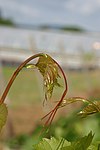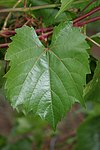3309 Couderc
| 'Couderc 3309' | |
|---|---|
| Synonyms | 3309 C - for more see section Synonyms |

|
|
| use | |
| origin | France |
| breeder | Georges Couderc |
| Breeding year | 1881 |
| VIVC no. | 3160 |
| ancestry | |
|
Hybrid of |
|
| List of grape varieties | |
' Coderc 3309' is a rootstock that belongs to the group of Vitis riparia × Vitis rupestris hybrids and is used for the biotechnical control of the roots of phylloxera in grape varieties susceptible to phylloxera. It is one of the weak to medium growing roots. It only brings satisfactory results on deep, lime-poor and nutrient-rich soils, if the distances between the plants are not too great.
ancestry
Is a cross of Vitis riparia TOMENTEUX × Vitis rupestris MARTIN by Georges Couderc , France, 1881.
Ampelographic features
- Shoot tip: closed to half-open, brownish green
- Young leaves: gray-green, tinged with brown, metallic, shiny, glabrous
- Fully grown leaves: small to medium-sized, usually wider than long, side lobes only indicated by broader end teeth, upper surface of the leaf very shiny, dark green with reddish bristled nerves, peduncles broadly V- to U-shaped
- Shoots: sunny side reddish brown, shiny and glabrous
- Flower: male pseudo-hermaphrodite
Properties - use
The rootstock has weak to medium growth and develops a shallow, not deep but strong root system. It only develops weak wood in the rootstock gardens. It has a low iron absorption capacity and therefore has a low to medium lime tolerance ( IPC = 10, active lime tolerance ~ 11%). It is sensitive to waterlogging in spring and is prone to potassium deficiency symptoms. With some noble varieties there are affinity problems and the nematode resistance is also low. The wood ripens late and the combination with slow-growing varieties leads to insufficient shoot development. It is too weak for large-area systems. The advantage is that it prematurely ripens the grapes and promotes fertility. In bloom sensitive varieties it reduces the trickling of the flowers.
This rootstock is only suitable for deep, lime-poor and nutrient-rich soils with regular water supply. Because of the low vigor, high planting densities have to be used in order to make optimal use of the planted area. Because of its disadvantages, the rootstock is not used in areas to the north.
Synonyms
- 3309 Couderc in the database Vitis International Variety Catalog of the Institute for Vine Breeding Geilweilerhof (English)
literature
- Karl Bauer, Ferdinand Regner , Barbara Schildberger: Viticulture (= AV book. ). 9th, updated edition. Cadmos, Vienna 2013, ISBN 978-3-7040-2284-4 .
- Desiderius P. Pongrácz: Rootstock for Grape-vines. David Philip Publisher, Cape Town et al. 1983, ISBN 0-908396-67-8 , pp. 58-59.
- Jancis Robinson : The Oxford Wine Lexicon. 3rd, completely revised edition. Hallwag, Munich 2007, ISBN 978-3-8338-0691-9 .
- Joachim Schmid, Frank Manty, Bettina Lindner: Geisenheimer grape varieties and clones (= Geisenheimer reports. 67). Geisenheim Research Institute - Department of Vine Breeding and Refinement, Geisenheim 2009, ISBN 978-3-934742-56-7 .
Individual evidence
- ↑ a b Joachim Schmid, Frank Manty, Bettina Lindner: Geisenheimer grape varieties and clones. 2009.
- ^ Karl Bauer, Ferdinand Regner, Barbara Schildberger: Viticulture. 9th, updated edition. 2013.
- ↑ Joachim Schmid, Frank Manty, Bettina Lindner: Geisenheimer grape varieties and clones. 2009, pp. 137-138.
- ^ Karl Bauer: Viticulture (= AV-Fachbuch. ). 8th, updated edition. Österreichischer Agrarverlag, Vienna 2008, ISBN 978-3-7040-2284-4 , p. 101.
Web links
- 3309 Couderc in the database Vitis International Variety Catalog of the Institute for Vine Breeding Geilweilerhof (English)
- Joachim Schmid, Frank Manty, Bettina Lindner: Geisenheimer grape varieties and clones (= Geisenheimer reports. 67). Geisenheim research institute - specialty grapevine breeding and refinement, Geisenheim 2009, ISBN 978-3-934742-56-7 , pp. 138-139. (PDF; 136 kB).



